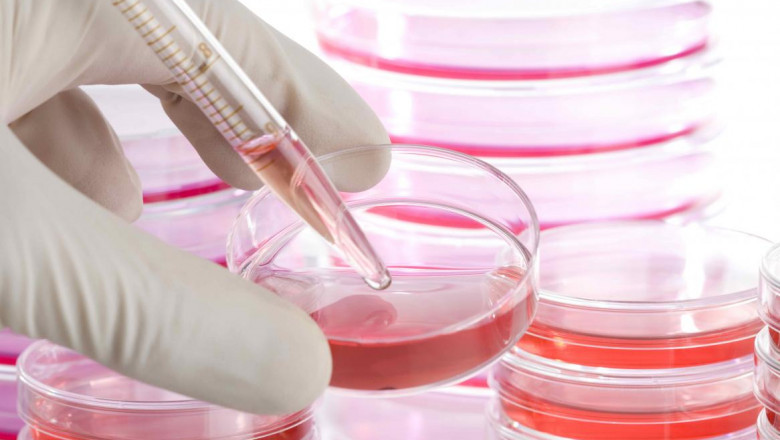views
Advances in Stem Cell Manufacturing Provide Hope for New Medical Treatments
Stem cells are special types of cells that have the unique ability to develop into different cell types in the body. They can differentiate into diverse specialized cell types like muscles cells, brain cells, blood cells etc. Stem cells are of two main types — embryonic stem cells that are derived from human embryos and adult stem cells that are found in various tissues like bone marrow, brain etc. Adult stem cells have limited differentiation potential compared to embryonic stem cells.
Advancements in Isolation and Growth of Stem Cells
Isolation of stem cells from various tissues requires precise techniques to separate them from other cells. Researchers have developed improved methods that utilize cell surface markers and growth factors to identify and extract stem cells. For embryonic stem cells, scientists have optimized techniques to culture them on feeder layers in controlled conditions maintaining their pluripotent state.
Advances in growing adult stem cells involve use of bioprocess engineering approaches. Bioreactors provide well-defined conditions for expansion of stem cells by controlling parameters like oxygen level, nutrients, growth factors etc. 3D bioprinting provides a way to culture stem cells on 3D scaffolds mimicking in vivo tissue structures and promoting cell differentiation. Such controlled techniques help overcome issues like contamination and ensure consistent stem cell production on an industrial scale.
Application of Gene Editing in Stem Cell Manufacturing
Stem Cell Manufacturing like CRISPR-Cas9 have enabled precisely modifying stem cell genomes. Researchers can knock-out or overexpress specific genes to understand their roles and direct cell fate. This helps generate stem cell lines with tailored properties according to application. For example, scientists have used CRISPR to disrupt HLA gene in stem cells to avoid immune rejection after transplant. Gene editing also allows creating “designer” stem cell lines carrying therapeutic genes which upon differentiation secrete factors to treat diseases.
Producing Stem Cells for Drug Development and Toxicity Testing
Pharmaceutical firms rely on stem cell derived cell types for drug discovery, efficacy and safety testing. Techniques to efficiently generate liver cells, heart cells, neural cells from stem cells are being optimized. These human cells better represent in vivo conditions for drug screening compared to cell lines. Stem cell produced hepatocytes, cardiomyocytes are being used to study drug metabolism and cardiotoxicity. Further, neural stem cell derived neurons and glia help assess neurotoxicity of potential drug candidates. Consistent production of such functional cell types helps accelerate pre-clinical drug development process.
Challenges in Scaling Up Stem Cell Manufacturing
While significant advances have been made in stem cell research, translating it into widespread therapeutic applications faces key challenges. Scaling up stem cell production process to an industrial level while maintaining stemness, differentiation ability requires further refinement. Development of automated and closed bioprocessing systems can help achieve consistent high yields of stem cells in hygienic conditions. Ensuring stem cell quality with respect to viability, sterility, genetic stability during large-scale expansion remains a hurdle. Other challenges involve developing methods for on-demand, “on-ask” production of different stem cell types cost-effectively meeting clinical needs. Overcoming these technological bottlenecks through multidisciplinary collaborations would propel commercial stem cell manufacturing.
Application of Stem Cells in Regenerative Medicine
Regenerative medicine aims to repair or replace damaged tissues and organs. Stem cells hold immense potential for regenerative therapies in conditions like Parkinson’s disease, diabetes, spinal cord injury where cells are lost. Techniques to differentiate stem cells into desired functional cells like dopaminergic neurons, insulin-producing pancreatic islets, oligodendrocytes are advancing. Further development is underway for engineered tissues utilizing scaffolds and growth factors to guide stem cells. Implanting stem cell produced tissues offers hope to patients who lack treatment options. Continued research to optimize stem cell culturing, targeted differentiation while ensuring safety would enable more regenerative medicine approaches to transition from lab to clinic.
From Therapeutic Cloning to Induced Pluripotent Stem Cells
Early attempts to generate patient-specific stem cells involved somatic nuclear transfer also known as therapeutic cloning. However, ethical concerns and technical difficulties limited its application. A major breakthrough was the discovery that mature cells can be reprogrammed to an embryonic stem cell like state through introduction of key transcription factors. These induced pluripotent stem cells (iPSCs) offer an ethically acceptable alternative to embryonic stem cells. iPSC technology spares the need for human embryos and allows generating patient and disease specific stem cells. Advancements in reprogramming methods now allow straightforward production of iPSCs from various cell types. These patient-specific stem cells show great potential in modeling diseases, drug testing, and autologous cell therapies after further refinements.
Quality Standards for Stem Cell Therapies
As stem cell based products and therapies reach clinical trials, establishing robust quality standards assumes significance. International organizations like the FDA are developing guidelines addressing critical factors like stem cell characterization, sterilization, cryopreservation, manufacturing consistency and purity. Adopting standards helps ensure safety and efficacy. Traceability systems allow tracking stem cells from donor to recipient. Development of potency assays to validate stemness and differentiation ability of manufactured cells lines is ongoing. Overall, establishing regulated practices supported by scientific data would aid translating Stem Cell Manufacturing into life-saving approved therapies benefiting patients worldwide.
Select the language you're most comfortable with.
French German Italian Russian Japanese Chinese Korean Portuguese
About Author: Ravina Pandya, Content Writer, has a strong foothold in the market research industry. She specializes in writing well-researched articles from different industries, including food and beverages, information and technology, healthcare, chemical and materials, etc. (https://www.linkedin.com/in/ravina-pandya-1a3984191)






















Comments
0 comment